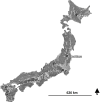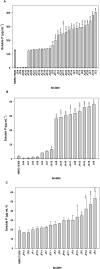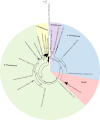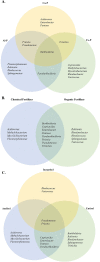Isolation and Characterization of Phosphate Solubilizing Bacteria from Paddy Field Soils in Japan
- PMID: 35598988
- PMCID: PMC9530731
- DOI: 10.1264/jsme2.ME21085
Isolation and Characterization of Phosphate Solubilizing Bacteria from Paddy Field Soils in Japan
Abstract
Phosphorus (P) is abundant in soil and is essential for plant growth and development; however, it is easily rendered insoluble in complexes of different types of phosphates, which may lead to P deficiency. Therefore, increases in the amount of P released from phosphate minerals using microbial inoculants is an important aspect of agriculture. The present study used inorganic phosphate solubilizing bacteria (iPSB) in paddy field soils to develop microbial inoculants. Soils planted with rice were collected from different regions of Japan. Soil P was sequentially fractionated using the Hedley method. iPSB were isolated using selective media supplemented with tricalcium phosphate (Ca-P), aluminum phosphate (Al-P), or iron phosphate (Fe-P). Representative isolates were selected based on the P solubilization index and soil sampling site. Identification was performed using 16S rRNA and rpoB gene sequencing. Effectiveness was screened based on rice cultivar Koshihikari growth supplemented with Ca-P, Al-P, or Fe-P as the sole P source. Despite the relatively homogenous soil pH of paddy field sources, three sets of iPSB were isolated, suggesting the influence of fertilizer management and soil types. Most isolates were categorized as β-Proteobacteria (43%). To the best of our knowledge, this is the first study to describe the genera Pleomorphomonas, Rhodanobacter, and Trinickia as iPSB. Acidovorax sp. JC5, Pseudomonas sp. JC11, Burkholderia sp. JA6 and JA10, Sphingomonas sp. JA11, Mycolicibacterium sp. JF5, and Variovorax sp. JF6 promoted plant growth in rice supplemented with an insoluble P source. The iPSBs obtained may be developed as microbial inoculants for various soil types with different P fixation capacities.
Keywords: Japan; phosphate solubilizing bacteria; rice; soil phosphorus fractionation.
Figures





Similar articles
-
Integrated use of phosphate-solubilizing Bacillus subtilis strain IA6 and zinc-solubilizing Bacillus sp. strain IA16: a promising approach for improving cotton growth.Folia Microbiol (Praha). 2021 Feb;66(1):115-125. doi: 10.1007/s12223-020-00831-3. Epub 2020 Oct 24. Folia Microbiol (Praha). 2021. PMID: 33099750
-
Isolation and characterization of phosphate solubilizing bacteria from rhizosphere soils of the Yeyahu Wetland in Beijing, China.Environ Sci Pollut Res Int. 2019 Nov;26(33):33976-33987. doi: 10.1007/s11356-018-2955-5. Epub 2018 Aug 25. Environ Sci Pollut Res Int. 2019. PMID: 30145765
-
Biochemical and molecular characterization of potential phosphate-solubilizing bacteria in acid sulfate soils and their beneficial effects on rice growth.PLoS One. 2014 Oct 6;9(10):e97241. doi: 10.1371/journal.pone.0097241. eCollection 2014. PLoS One. 2014. PMID: 25285745 Free PMC article.
-
Prospects for Using Phosphate-Solubilizing Microorganisms as Natural Fertilizers in Agriculture.Plants (Basel). 2022 Aug 15;11(16):2119. doi: 10.3390/plants11162119. Plants (Basel). 2022. PMID: 36015422 Free PMC article. Review.
-
Development of low-cost formulations of plant growth-promoting bacteria to be used as inoculants in beneficial agricultural technologies.Microbiol Res. 2019 Feb;219:12-25. doi: 10.1016/j.micres.2018.10.012. Epub 2018 Nov 2. Microbiol Res. 2019. PMID: 30642462 Review.
Cited by
-
The Application of Sulfur Influences Microbiome of Soybean Rhizosphere and Nutrient-Mobilizing Bacteria in Andosol.Microorganisms. 2023 May 3;11(5):1193. doi: 10.3390/microorganisms11051193. Microorganisms. 2023. PMID: 37317167 Free PMC article.
-
Agronomic strategies to enhance the early vigor and yield of maize. Part I: the role of seed applied biostimulant, hybrid and starter fertilization on rhizosphere bacteria profile and diversity.Front Plant Sci. 2023 Nov 2;14:1240310. doi: 10.3389/fpls.2023.1240310. eCollection 2023. Front Plant Sci. 2023. PMID: 38023909 Free PMC article.
-
Revealing the Existence of Diverse Strategies for Phosphorus Solubilization and Acquisition in Plant-Growth Promoting Streptomyces misionensis SwB1.Microorganisms. 2025 Feb 9;13(2):378. doi: 10.3390/microorganisms13020378. Microorganisms. 2025. PMID: 40005744 Free PMC article.
-
The role of endophytic salt-tolerant Franconibacter Sp. YSD YN2 in Cyperus esculentus L. Var sativus: impacts on plant growth and mechanisms of salt tolerance.BMC Plant Biol. 2025 Apr 28;25(1):553. doi: 10.1186/s12870-025-06562-2. BMC Plant Biol. 2025. PMID: 40295918 Free PMC article.
References
-
- Álvarez-López, V., Prieto-Fernández, A., Janssen, J., Herzig, R., Vangronsveld, J., and Kidd, P.S. (2016) Inoculation methods using Rhodococcus erythropolis strain P30 affects bacterial assisted phytoextraction capacity of Nicotiana tabacum. Int J Phytorem 18: 406–415. - PubMed
-
- Ando, K., Yamaguchi, N., Nakamura, Y., Kasuya, M., and Taki, K. (2021) Speciation of phosphorus accumulated in fertilized cropland of Aichi prefecture in Japan with different soil properties by sequential chemical extraction and P K-edge XANES. Soil Sci Plant Nutr 67: 150–161.
-
- Arcand, M.M., and Schneider, K.D. (2006) Plant- and microbial-based mechanisms to improve the agronomic effectiveness of phosphate rock: a review. An Acad Bras Cienc 78: 791–807. - PubMed
-
- Bakhshandeh, E., Rahimian, H., Pirdashti, H., and Nematzadeh, G.A. (2015) Evaluation of phosphate-solubilizing bacteria on the growth and grain yield of rice (Oryza sativa L.) cropped in northern Iran. J Appl Microbiol 119: 1371–1382. - PubMed
-
- Banik, S., and Dey, B.K. (1983) Phosphate-solubilizing potentiality of the microorganisms capable of utilizing aluminium phosphate as a sole phosphate source. Zentralbl Mikrobiol 138: 17–23. - PubMed
MeSH terms
Substances
LinkOut - more resources
Full Text Sources
Molecular Biology Databases
Miscellaneous

